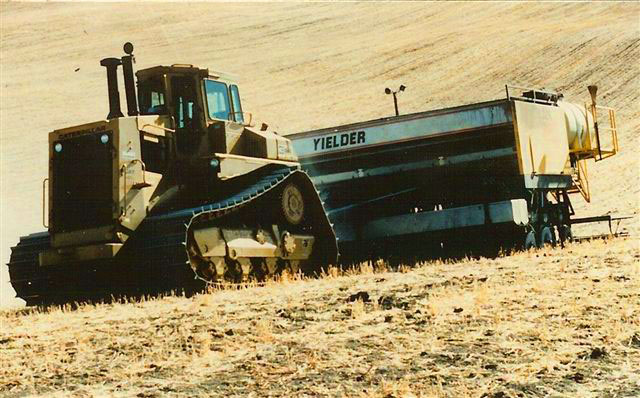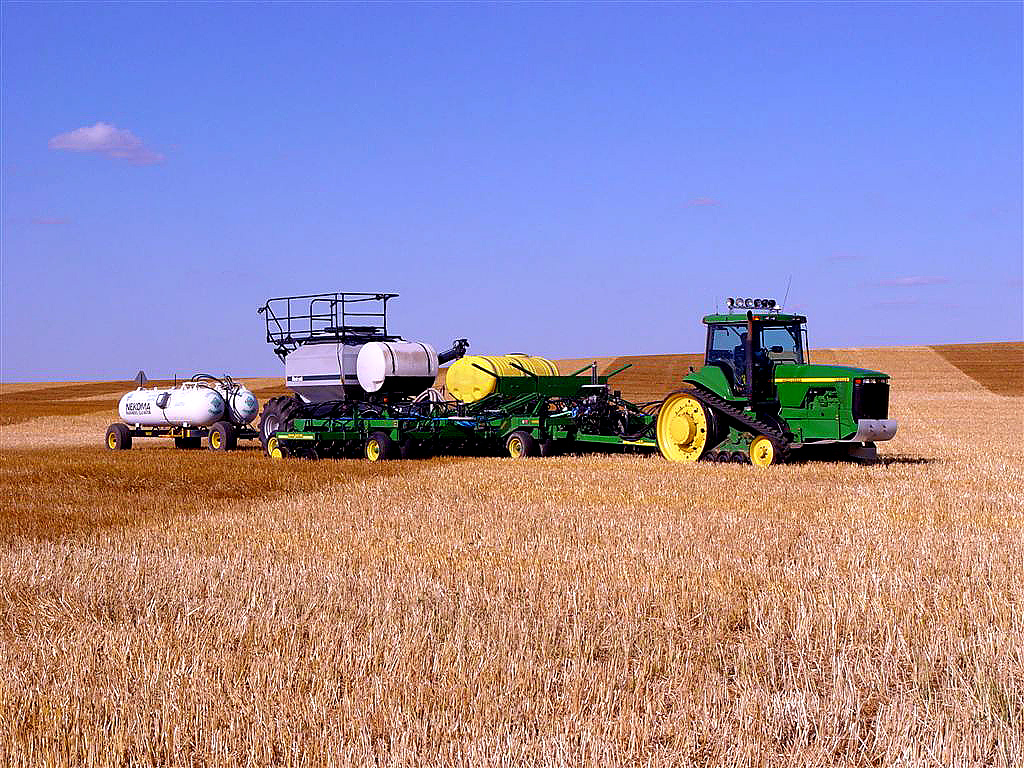- Take multiple samples
- Use clean equipment
- Only use stainless steel equipment
- only take a sample 4 inches deep
Views from the Field
Thursday, May 24, 2012
Wednesday, May 23, 2012
The Life of a Cotton Plant
 |
| As you can see all of the grass and such is turned under |
The freshly disked ground is then seeded by a planter, which plant between 6 and 48 rows depending on the size of the planter. Many times during planted fertilizer and other chemicals may be added.
| A 48 row planter |
 |
| A 24 row planter |
 |
| A cotton boll |
After the boll appears it is ready to be picked. There is a special machine just referred to as a cotton picker which only has the capabilities to pick cotton.
 |
| A cotton picker |
Thursday, May 17, 2012
Grain Carts
One dilema that many farmers will come across in their careers is the decision whether to add a grain cart to their equipement lineup. A grain cart can save a farmer quite a bit of time and money. Grain carts are driven beside a combine, so that the combine can unload the hopper and never leave the field. This saves the time it takes to stop picking, and go, sometimes long distances, to the grain truck. This saves hours on the combine and money by having less downtime. However, grain carts are a bit of an investment a 1000 bushel cart can be around $113,000 for the 1,000 bushel model. It is also necessary to have a tractor that can pull it which is generally 250 hp+.
 |
| A view from a combine unloading into a grain cart |
Tuesday, May 15, 2012
No-till planting
 |
| An older style seed drill |
Perhaps one of the greatest farming techniques of all time is no-till farming. No-till has many advantages, with very few disadvantages. No-till allows a field to be planted with out disturbing the organic matter already in the field. This allows more nutrients to get to the plant, without purchasing expensive chemicals. It also helps in the prevention of soil erosion, because the roots of the grass and other plants in the field hold the soil while the seed is germinating. However, the downside is that the equipment used to plant in this no-till environment can be very expensive. One of the machines at the heart of the process is called a no-till planter. This machine works with a series of round blades called openers. These openers create a small trench called a vee, this vee is where the seed is dropped. A set of smooth wheels run behind and close the vee, creating the perfect environment for the seed. No-till can be a fairly slow process only running at about 4mph. No-till equipement is available in various different sizes, as shown below.
 |
| A Small Planter Meant to be Pulled by an ATV |
 |
| A Very Large No-Till Planter |
 |
| One unit of a multi-unit no-till planter. |
Thursday, May 10, 2012
Biodiesel
Since my post on Tuesday was a hout the use of ethanol, i think it inly fit to talk about biodiesel today. Biodiesel is blended with regular diesel at about 20% biodiesel and 80% regular diesel. This blend has proved to be very good. It does not show a significant decrease in fuel efficiency. However the only problem that may pose a problem is that sometimes, biodiesel can gum-up the fuel injectors. This seems like a problem that could be fixed with a little more research. Like ethanol biodiesel can help reduce our dependance on foreign oil. Overall I believe that biodiesel is a fuel with great potential.
 |
| Sources of Raw Materials Used to Produce Biodiesel |
 |
| How Biodiesel is Made |
Tuesday, May 8, 2012
Ethanol
The us of ethanol in place of gas is a widely debated topic, the use of ethanol has its pros and cons. For example ethanol decreases our dependance on foreign oil. However, it ethanol sits in a fuel tank for a long period of time, it separates into its components, a major one being water. We all know that engines don't run on water and it can decrease the life of the engine by having water in the gasoline.
Pros:
Pros:
- Ethanol decreases our dependance on foreign oil
- Ethanol provides a new market for farmers to sell their crops to.
- Cheap
- Many of the grains bought for the production of ethanol are purchased from Brazil.
- Bad for the environment
- Splits into fuel and water...bad for any engine
Ethanol Production
Friday, May 4, 2012
Grain Dryers
One of the various things that we are working on on the farm is the grain dryers. In order to get optimum price at market, grains need to be at specific moisture level, depending on what type of grain. Grain dryers utilize huge axial fans and huge amounts of heat to expedite the drying process.
The average horsepower of of a grain dryer is about 15, which is about 270 times the strength of your average household fan. However, some of these machines can get up in the range of 75 horsepower, about 1125 times that of the average household fan.
In addition to incredible air speeds heat is also added via a large propane burner mounted inside the fan housing. Average BTU( British Thermal Units ), which is a measure of the heat output capabilities, in a 2300 square foot home is 100,000. A grain dryer can do over 2,000,000 BTU in a space about 500 square feet.
On the farm we have a total of four of these beasts ranging from 15-20 horsepower. In order to prevent a catastrophic explosion these machines must be maintained regularly. Before I was even born we had a grain dryer blow up an entire grain bin. There is still a huge crater in the ground where the bin used to sit, and there is still metal that is lodged in the ground so tight that it can not be pulled out with our tractor. The way these explosions happen is that the circuit that controls the gas shut off malfunctions. This allows the entire grain bin to be filled with propane gas, and the when the machine is ready to begin drying and lights the burner, everything is blown to smithereens in a matter of seconds. However, with proper maintenance, which includes regular inspection, proper cleaning, and regular testing of electrical controls, these machines can be operated safely.
The average horsepower of of a grain dryer is about 15, which is about 270 times the strength of your average household fan. However, some of these machines can get up in the range of 75 horsepower, about 1125 times that of the average household fan.
In addition to incredible air speeds heat is also added via a large propane burner mounted inside the fan housing. Average BTU( British Thermal Units ), which is a measure of the heat output capabilities, in a 2300 square foot home is 100,000. A grain dryer can do over 2,000,000 BTU in a space about 500 square feet.
On the farm we have a total of four of these beasts ranging from 15-20 horsepower. In order to prevent a catastrophic explosion these machines must be maintained regularly. Before I was even born we had a grain dryer blow up an entire grain bin. There is still a huge crater in the ground where the bin used to sit, and there is still metal that is lodged in the ground so tight that it can not be pulled out with our tractor. The way these explosions happen is that the circuit that controls the gas shut off malfunctions. This allows the entire grain bin to be filled with propane gas, and the when the machine is ready to begin drying and lights the burner, everything is blown to smithereens in a matter of seconds. However, with proper maintenance, which includes regular inspection, proper cleaning, and regular testing of electrical controls, these machines can be operated safely.
Subscribe to:
Posts (Atom)



